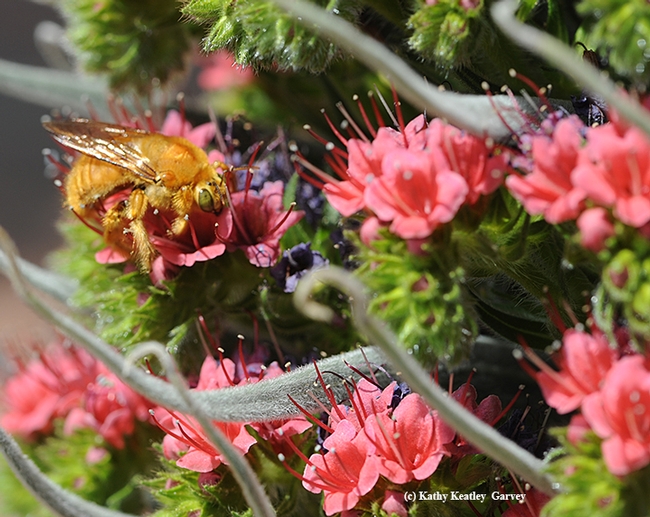You're likely to see many species of bees at the Häagen-Dazs Honey Bee Haven open house from 11 a.m. to 2 p.m. on Saturday, April 9 on Bee Biology Road, University of California, Davis.
The half-acre bee garden, operated by the UC Davis Department of Entomology and Nematology and primarily funded by the premier ice cream brand, was planted in the fall of 2009. It's located west of the central campus, next to the Harry H. Laidlaw Jr. Honey Bee Research Facility.
The garden contains scores of bee friendly plants, visited by honey bees, bumble bees, carpenter bees, sweat bees, European wool carder bees and other pollinators.
Two of the bees you'll see Saturday are the Valley carpenter bees. The male and females are clear examples of sexual dimorphism. The male, often called "a teddy bear bee," is blond with green eyes, while the female is a solid black.
Native pollinator specialist Robbin Thorp, distinguished emeritus professor of entomology at UC Davis, collected a couple of the male Valley carpenter bees today for the spring open house. If you're apprehensive about touching them, don't bee. "Boy bees don't sting," he says.
A six-foot-long sculpture of a worker bee, "Miss Bee Haven," the work of Donna Billick of Davis, anchors the haven. Throughout the garden, you'll see the ceramic mosaic work of the UC Davis Art/Science Fusion Program, co-founded and co-directed by Diane Ullman, professor of entomology at UC Davis, and Billick, a self-described "rock artist."
The garden took shape under then interim department chair Lynn Kimsey, professor of entomology at UC Davis and director of the Bohart Museum of Entomology. Scores of professionals and volunteers made it all possible. (See History of the Haven.)
Today it is managed by entomologists Christine Casey, staff program representative, and Extension apiculturist Elina Niño, faculty director of the haven.
The open house will include a tour of the garden at noon. Other activities:
- Learn to catch and observe bees up close
- See honey bees at work in an observation beehive
- Learn about bee diversity and identification
- Learn about what and how to plant for bees
Attached Images:

